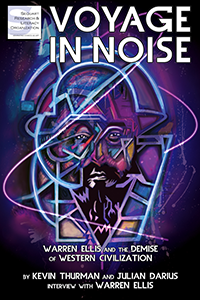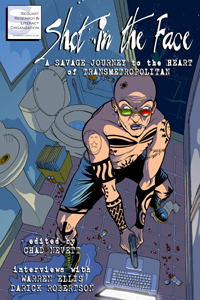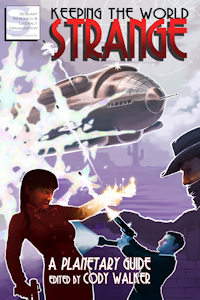Warren Ellis hates super-heroes.
At least, that’s what people say. He certainly has played his part, through a few off-the-cuff remarks, in this misconception. But it would be more accurate to say that Ellis hates how much the super-hero genre dominates comics.
Ellis also didn’t grow up immersed in super-heroes, the way many comics creators did. There’s no denying that Ellis has written several of the most important super-hero comics from the 1990s onward. Reading them, it’s hard to imagine they aren’t rooted in some kind of love, even if it’s not a childhood one.
Call it a love-hate relationship, then.
For some people, Superman’s the symbol for all super-heroes, having arguably been the first. I’d argue that, for Ellis, this role is taken by the Fantastic Four.
This may at first seem counter-intuitive. After all, the Fantastic Four didn’t inaugurate the so-called Golden Age of super-heroes, nor even the Silver Age. That latter honor belongs to DC’s reinvented Flash. The Fantastic Four did, however, inaugurate Marvel’s later Silver Age.
Marvel’s output would come to dominate super-hero comics sales. By the 1970s, DC had already started imitating its corporate rival. For almost the entire time that Ellis has been working in super-hero comics, beginning at Marvel, he’s worked in a landscape that traces its origins back through the Fantastic Four.
This is more than historical accident. Superman may have been the first super-hero, but he had one foot still firmly in the pulps. The Silver-Age Flash, whose alter ego was a police scientist, was half super-hero and half sci-fi adventurer. When DC retooled Green Lantern and Hawkman for the Silver Age, both had new, extraterrestrial origins for their powers.
But the Fantastic Four? That was pure super-hero action, from start to finish. Sure, their origins were tied to the Space Race, but that was the thinnest of excuses. And by the end of their first issue (Nov 1961), they were fighting Mole Man, simply because it sounded cool.
Ruins
Ellis’s first major depiction of the Fantastic Four came in Ruins, his two-issue follow-up to the immensely popular Marvels. Marvels, by Kurt Busiek and Alex Ross, offered an unapologetic celebration of Marvel super-hero history. In Ruins, Ellis rejected that history in half the space, presenting a parallel, more logical Earth in which radioactive spider bites didn’t lead to super-powers without side effects.
After skewering super-hero after super-hero, Ellis finally gets around to the Fantastic Four towards the end of Ruins #2 (Sept 1995). In this version, Ben Grimm refuses to pilot the stolen space vehicle on the grounds that it lacks “lateral motors.” It’s this lack of proper preparation that causes the disaster. In other words, Reed Richards wasn’t only a thief; he was a stupid thief too.
This Johnny Storm doesn’t develop the power to burst into flames and fly around, becoming the Human Torch. Instead, he “caught fire at cellular level — burned from the bones outward.” It may seem cynical, but this points out that the Human Torch actually has immunity to his own flame — and what are the odds of that developing?
Sue Storm gets invisibility, just like in the normal version of the story. But all of her body reflects light, including her eyes, “so she was actually blind. / They didn’t know she was there until she fell on her brother,” who by then was a burning corpse.
Victor Von Doom flew the ship, when Ben Grimm refused, and thus got the Thing’s powers instead. “They said he was animal when he went up, and mineral when he came down,” the surviving Ben Grimm narrates. “They say he was wearing his internal organs on the outside.” There’s no reason why this should necessarily be case (and it’s only rumor anyway). But it does illustrate that a man who’s turned to rock is not likely to remain viable as an organism.
It’s a devastating (though not entirely original) deconstruction of the Fantastic Four. But it’s also implicitly the point of divergence between the Ruins universe and the normal Marvel one. Ben Grimm says, “I can’t help thinking it woulda been different if I’d flown her.” After this, all that remains is the epilogue, with one final twist. The Fantastic Four is the origin of everything, and in Ruins, their normal origin is exposed as always already corrupted by mind-bending stupidity.
Planetary
Ellis returned to the Fantastic Four in Planetary, this time published by DC’s WildStorm imprint. Each issue, the series explored a different genre or set of characters, usually renamed for reasons of copyright. Most such characters weren’t super-heroes, although it’s worth noting that the first Planetary story, in Planetary Preview #1 (Sept 1998) is centered around a deconstruction of the Hulk’s origin story that’s almost dark enough to feel at home in Ruins.
Ellis didn’t get around to the Fantastic Four until Planetary #6 (Nov 1999). There, Ellis ties the Four’s space vehicle to Nazi rocket scientist Wernher von Braun, whom the United States secreted away and who contributed to the Space Race — in real life. With this fact alone, Ellis deconstructs the happy, smiling version of American space technology in the same way that he’d previously deconstructed super-powers.
The Four, as Planetary calls them, did gain super-powers that didn’t kill them. Ellis was trying to reign in his darkness on Planetary, in hopes of producing a more commercial product — hopes that were rewarded. (My essay in Keeping the World Strange expands upon this.) Still, the disaster that gives the Four their powers is depicted as painful and horrible — and it destroys their bodies, even as it transfigures them into something else.
Oh, and did I mention the Four are bad guys?
What makes all of this so curious is that (outside of that Planetary Preview #1), the series had previously been so hopelessly optimistic. Even when the story involved horrible, horrible things, Ellis would typically make sure the ending recast everything as wonders that make the characters smile — a move borrowed from Marvels, not its opposite, Ruins. Most of the oddities encountered were friendly, or at least not utter villains like the Four.
Why was the first issue of Planetary that directly explored super-hero stories — and the Fantastic Four in particular — also such a departure into darkness?
One answer may be found in the issue itself, which shows that the Four have suppressed many fantastical discoveries from the world.
The WildStorm Universe, founded in the 1990s, was a dark and violent place. Implicitly, this was the Four’s fault. As in Ruins, it all goes back to the Fantastic Four.
But in Planetary, which celebrates the pulp tradition out of which super-heroes came, one can also read the Four as suppressing the natural evolution of those wonders. Although later issues would emphasize the Four’s suppression of world-changing technology, the emphasis in Planetary #6 was decidedly upon the fantastic for its own sake (and especially on elements from early Fantastic Four stories).
In a series that excavates the history of fantastical literature, the Four’s suppression of these elements parallels how the super-hero derailed the natural progression of the pulps. Those quasi-literary adventures disappeared behind the super-hero formula inaugurated by the Fantastic Four.
No wonder the Four, introduced in Planetary #6, became the ruthless villains of the entire series. They’re so evil that, when the real origin of their powers is finally revealed (in Planetary #25, June 2006), it’s that they sold the Earth to an evil alien intelligence.
Super-hero fans may love Planetary. It may represent Ellis tampering his cynical tendencies to give super-hero comics readers what they want. But the series also contains a savage criticism of the entire genre — one centered around the Fantastic Four.
The Ultimate Fantastic Four
Planetary and to an even greater extent The Authority, which Ellis also launched for WildStorm in the same period, shot Ellis into the ranks of comics’ most popular writers.
In 2004, when writers Brian Michael Bendis and Mark Millar quit the new Ultimate Fantastic Four after six issues, Marvel turned to Warren Ellis. And suddenly the man who had made his career in significant part through works skewering or demonizing the Fantastic Four found himself with the task of writing them straight.
Ellis made an admirable job of the task. The series, set in Marvel’s Ultimate Universe, featured updated versions of its characters. Bendis and Millar had already infused this new Fantastic Four with a realism unparalleled for the characters. Ellis now carried this forward.
In his very first issue (#7, Aug 2004), he has the characters question how their powers work. After running tests on the rocky Ben Grimm, Sue Storm says she can’t figure out “how he’s breathing. He weighs, like, half a ton. How does he inflate his lungs?” She also points out that Reed hasn’t needed to eat since the accident and claims he has no internal organs: “It kind of has to be possible. Where do your insides go when you stretch out? / More to the point: if your insides stretch, where would the burger you just ate go?”
In the next issue (#8, also Aug 2004), Reed asks Ben, “Can you still go to the bathroom?” After a long pause, Ben replies, “You don’t wanna know the details.”
Why, it’s almost like the Fantastic Four had read Ruins or something.
Ellis’s second storyline (#13-18, Jan-June 2005) reimagined the Negative Zone, which had been little more than a contrivance in the original stories, as a quasi-scientific space. Instead of simply popping into it, journey there was arduous, involving a retooled space shuttle. And in classic sci-fi pulp adventure fashion, this space had truly alien and hostile inhabitants.
Indeed, Ellis’s Fantastic Four might even be considered to be influenced as much by quasi-realistic adventure pulps as by super-hero traditions. Again and again, he grounded silly, super-hero tropes in pseudo-scientific concepts — a manner that was arguably closer to Silver Age DC than the super-hero formulas inaugurated by the Fantastic Four.
But Ellis’s greatest coup, in this regard, wasn’t even in Ultimate Fantastic Four, which he only wrote for 12 issues. It was in his Ultimate Galactus trilogy, which retold what is probably the most famous Fantastic Four story ever — the coming of Galactus — without focusing on the Fantastic Four.
In the story’s original version, culminating in Fantastic Four #50 (May 1966), Galactus was a giant in purple and blue armor with a big “G” on his chest — a wild, stupid, super-hero cliche if ever there were one. He threatened to consume the world’s energies but was stopped by Reed Richards threatening to use and even stupider device: a tiny, weird-looking thing called the Ultimate Nullifier, fear of which caused Galactus to leave Earth.
In Ellis’s version, culminating in Ultimate Extinction #5 (July 2006), Ellis recast Galactus as a swarm of interplanetary machines that operated with a hive consciousness. A character that had seen other planets destroyed by the swarm had come to Earth to warn it only to crash, causing the famous Tunguska explosion. In a brilliant move, Ellis used the swarm — termed Gah Lak Tus — as an explanation for the Fermi paradox, the real scientific debate over why we can’t observe evidence of advanced extraterrestrial civilizations, despite our best mathematical guesses telling us that we should be able to.
Like the original, this “Gah Lak Tus” also wanted to consume Earth, causing the requisite drama. But Ellis’s most brilliant innovation was how the swarm was stopped: using the same technology that had created the Fantastic Four in the first place, only now fueled by baby universes. Here, Ellis borrowed from actual scientific theory of how multiple universes might be structured, and the destruction of these universes made his heroes far less morally pure, thus defying another super-hero trope.
Even this technology, however, didn’t defeat Gah Lak Tus. After all, what are the odds that a being that has consumed countless planets would happen to be stopped by Earth? No, this technology only allowed Earth to wound the swarm, and it left based solely on the calculation that it would expend too much in resources to consume Earth, as opposed to moving on to the next world.
Warren Ellis’s depictions of the Fantastic Four have softened over the years. He first deconstructed the Fantastic Four’s powers in Ruins. In Planetary, he let them have their unrealistic powers but made them evil and detrimental not only to the fictional world but to our own fictions of the fantastic. Finally, in Ultimate Fantastic Four and the Ultimate Galactus Trilogy, Ellis let the Fantastic Four have their powers and be good guys. But he did so while infusing the Fantastic Four with the intelligence he had originally criticized the characters as lacking.
Maybe it takes someone who can see through super-heroes to save them.

































































